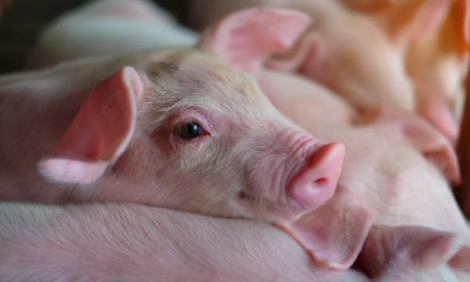



Using South Dakota Grown Field Peas In Swine Diets
By Bob Thaler, Extension swine specialist and Hans Stein, assistant professor, animal science, South Dakota State University - Due to changes in crop rotations, field peas are now more commonly grown in central South Dakota.
 Depending on variety, they can either be sold for human consumption or fed directly to livestock. Beef producers can bale the entire plant and feed it as a forage to ruminants, and swine producers can use the seed as a protein and energy source.
Depending on variety, they can either be sold for human consumption or fed directly to livestock. Beef producers can bale the entire plant and feed it as a forage to ruminants, and swine producers can use the seed as a protein and energy source.
Nutrient composition
Field peas can be both an amino acid and energy source for pigs. Their amino acid content
is intermediate between corn and soybeans and, depending on variety, their energy concentration
can be similar to that of corn. A general nutrient analysis for field peas is shown in Table 1.

Amino acid source
There are many different varieties of field peas, and nutrient content can vary greatly between them. For example, crude protein can range from 15.5 to 39.7% between different pea varieties. However, varieties typically grown in South Dakota contain approximately 21-23% crude protein.
As with soybean meal, field peas are a good source of lysine, usually the first limiting amino acid for pigs. The lysine in field peas is highly digestible, with a lysine digestibility value similar to that found in soybean meal. This enhances the economic value of field peas in swine diets. Unfortunately, field peas are low in the sulfur amino acids methionine and cystein and are
marginal in tryptophan. Research has also shown that the digestibilities for these three amino acids are lower than those found in soybean meal.
You may need to add synthetic methionine and tryptophan to diets containing high levels of
field peas.
Energy source
Field peas are low in fat (0.9%) and contain twice as much fiber (5.6%) as corn. Therefore, it
could be expected that they would be lower in energy, as seen in Table 1.
However, as was the case with protein levels, energy concentrations vary greatly between varieties. SDSU research has shown that the variety ‘Carneval’ has a metabolizable energy concentration of 3407 kcal/kg, very similar to the energy level found in corn. Findings from recent Canadian work on 11 different varieties have also shown field peas grown in the upper Great Plains can have metabolizable energy values (av 3476 kcal ME/kg) comparable to corn.
If using the newer varieties grown in this region, you can assume they will have an energy concentration similar to that of corn and that you will not have to adjust the dietary energy level.
Anti-nutritional factors
Field peas, especially the dark flowered varieties, contain several anti-nutritional factors such
as lectins, protease inhibitors, and tannins. These can reduce feed intake and growth rate.
However, the concentrations of these factors are much less than those found in raw soybeans, and for all practical purposes, field peas can be fed raw and do not have to be heat-treated to obtain
acceptable pig performance.
Unlike raw soybeans, raw field peas do not have a palatability problem.
Incorporating field peas into swine diets
Since it can be assumed that field peas grown in South Dakota have an energy concentration similar
to corn, diets containing field peas can simply be balanced on digestible amino acid concentrations.
Balance first on lysine concentration. Then analyze the diet for concentrations of methionine,
tryptophan, and threonine. If feeding high levels of field peas, synthetic additions of these three amino acids may have to be made.
Another method to incorporate field peas into swine diets is a simple substitution method. We have replaced 4 parts corn and 2 parts SBM with 6 parts field peas. For example, 18% field peas would replace 12% corn and 6% SBM in the diet. Again, this will meet the lysine level, but the concentrations of methionine, tryptophan, and threonine always have to be checked when utilizing field peas.
Table 2 shows the recommended levels of field peas for the different classes of swine. Fed at
these levels, field peas will support normal growth and feed efficiency, and will not negatively affect carcass characteristics.

Varietal differences
Do not forget the great difference between the different varieties of field peas. It is essential
that you know the variety you are working with before trying to incorporate field peas into swine
diets.
In general, white flowered peas have higher energy and amino acid availabilities for swine than
varieties with colored flowers. This makes white flowered peas preferred for feeding to swine.
Round seeds also appear to be nutritionally superior to wrinkled seeds. However, it is still recommended that the peas be analyzed for nutrient content before formulating diets with them.
Summary
Field peas are a good source of energy and amino acids for swine. However, variety differences exist, and producers must know the nutrient content of the peas they are working with to
properly formulate them into swine diets.
Field peas are a good source of lysine, but the concentrations of methionine, tryptophan, and threonine must be watched closely.
While peas can contain anti-nutritional factors, they are usually in such a low concentration that field peas can be fed raw.
Depending on economics, field peas can work well in diets for all classes of swine.
For more information, contact your county Extension educator
or the authors at 605-688-5165.
Source: College of Agriculture & Biological Sciences / South Dakota State University in association with the USDA - December 2003








